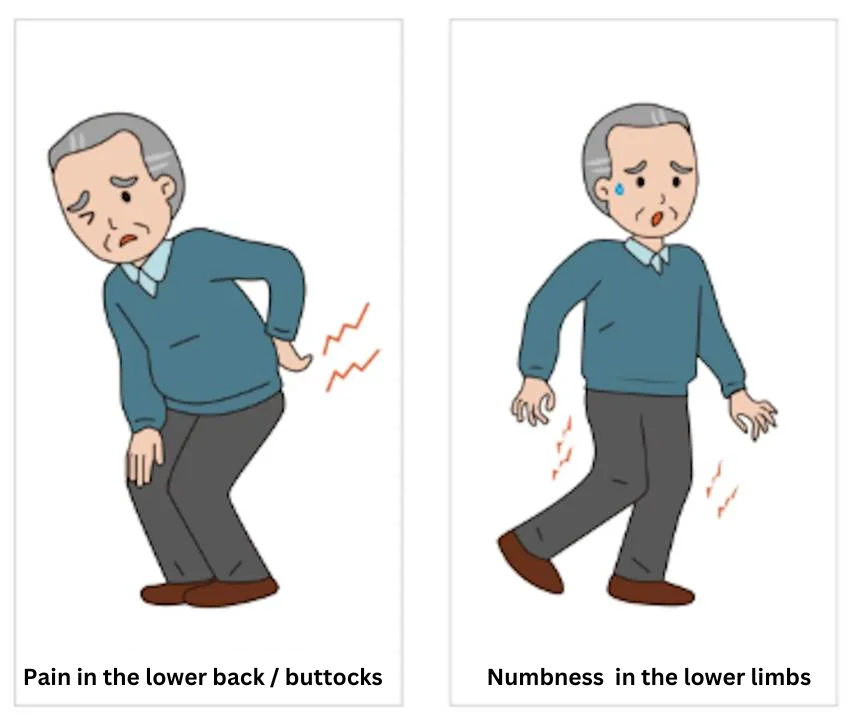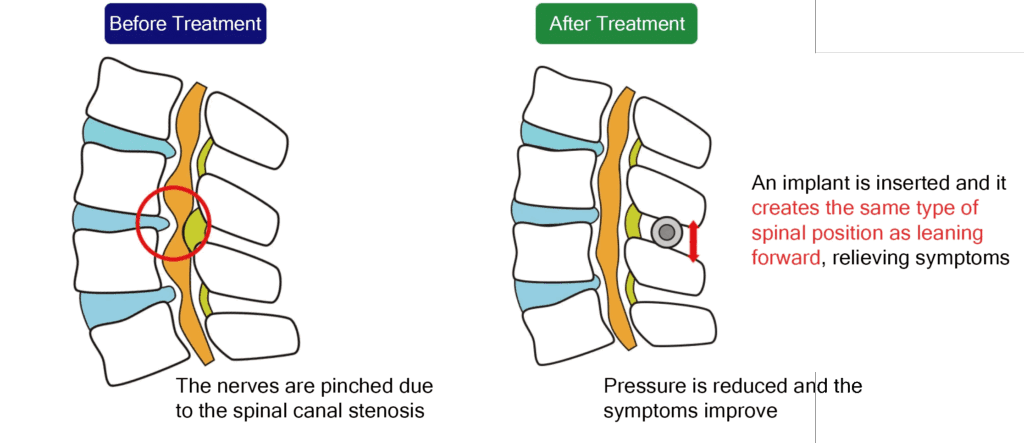Column What Are The Early Symptoms of Spinal Canal Stenosis? Frequently Overlooked Signs and Methods for Early Treatment
June 20, 2025
The condition in which the nerve pathways (i.e., the spinal canal) in the spine have narrowed is called spinal canal stenosis.
In this article, we will discuss the initial symptoms and preventive measures for lumbar spinal canal stenosis.
What is spinal canal stenosis?
Spinal canal stenosis is a condition in which the spinal canal, which is the pathway for the spinal nerves, becomes stenosed (i.e. narrowed), causing a compression of the nerves. When it is caused by instability of the lumbar spine, it often causes pain during physical movements.
Early symptoms of spinal canal stenosis
The initial symptom of spinal canal stenosis is back pain. Standing up or walking causes the lower back to stretch, further narrowing the spinal canal and increasing the pressure on the nerve, which also contributes to aggravating the pain.
If the nerve compression rises beyond a certain limit, pain and numbness in the lower limbs may occur.

The following symptoms are all indicative of spinal canal stenosis and should be considered with caution.
・Pain increases when standing or walking, but is relieved when sitting or bending over.
・Walking is difficult, but riding a bicycle is not a problem.
・Bending over backward is difficult.
If you experience any of these symptoms, we recommend that you seek professional medical advice as soon as possible.
The risk associated with leaving spinal stenosis untreated
Although spinal stenosis does not cause severe pain in its early stages, if the pain becomes severe or symptoms in the lower limbs (such as intermittent claudication) or urinary or stool problems occur, it indicates that the disease is progressing.
For example, the following conditions may indicate that spinal canal stenosis has progressed.
・Numbness in the legs even when lying on the back.
・Pain or numbness occurring regardless of which position you are in.
・Difficulty in sleeping unless the patient lies on his/her side and rounds his/her back.
・Difficulty with urination and bowel movements
・Decreased walking duration.
・Significant muscle weakness
If the patient thinks “it’s OK, the pain is not that bad” and leaves it untreated, spinal canal stenosis will progress, eventually interfering with daily life, and recovery may not always be possible, even with surgical intervention.
How to prevent spinal canal stenosis
It is important to prevent spinal canal stenosis by developing an exercise routine, being aware of the proper posture, and reducing the strain on one’s back.
Be mindful of the proper posture
Pay attention to your posture in daily life to reduce the strain on your back.
Avoid adopting a slouched posture, as it aggravates the symptoms of spinal canal stenosis.
When sitting, the posture should be upright with one’s pelvis erect and the back kept straight.
It will be easier to walk if you are aware of the sacrum in the middle of the pelvis when walking.
Exercise routines
Start with low-impact exercises such as walking, swimming, and cycling.
Exercises that strengthen the muscles that stabilize the spinal column (especially those around the waist) are effective in preventing spinal canal stenosis.
Reduce the strain on the lower back in everyday life
Avoiding the same posture for long periods of time can also help. When lifting heavy objects, try to bend your knees instead of bending at the waist.
Our clinic’s treatment: the Florence Method and the Q-Florence Method
Our clinics perform the Florence Method and the Q-Florence Method as treatments for spinal canal stenosis.
The Florence and Q-Florence procedures are minimally invasive, low-risk treatments for spinal canal stenosis.
Under partial anesthesia and sedation, a device is percutaneously inserted to widen the narrowed spinal canal.
The device is inserted to stabilize the vertebral body while maintaining spinal rotation and flexion, widening the spinal canal and reducing disc protrusion and the thickening of ligamentum flavum. Pain is eliminated by widening the narrowed spinal canal.
The Florence and Q-Florence methods are minimally invasive and low-risk procedures, and there have been no reports of post-treatment complications or recurrence of symptoms.

The Q Florence Method (article in Japanese)
If you suffer from spinal canal stenosis, please consider having a consultation at our clinic.
Related Articles
Lumbar Spinal Canal Stenosis: What is Actually Happening to my Body?
The Different Symptoms of Spinal Canal Stenosis: If You Have Any of These, it’s a Red Flag!
What are the Various Complications Possible With Spinal Stenosis?
Why Do the Symptoms of Spinal Stenosis Differ From Person to Person?
Diagnosis and Treatment of Spinal Stenosis: Why Early Detection is Critical
Treatment of Spinal Canal Stenosis: The Various Conservative Treatments and Surgical Options



